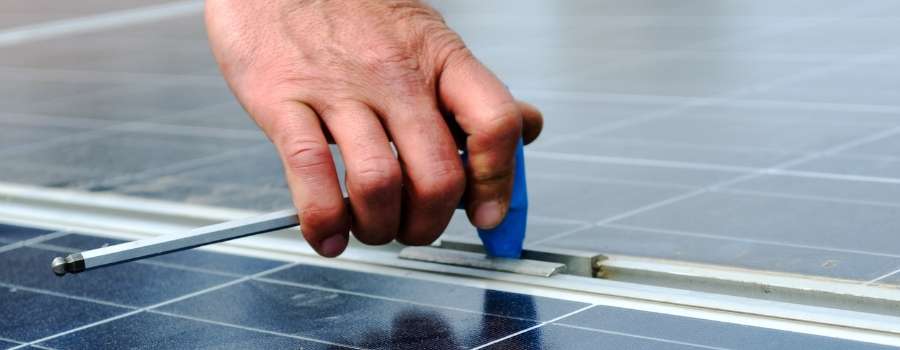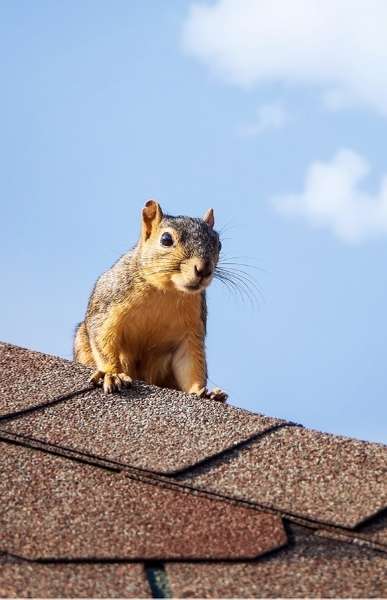
Now that you have made the decision to invest in solar panel technology it’s time to get down into the nitty-gritty of how you’re actually going to mount those panels on your property!
And while plenty of people opt to set up “standalone” solar panel arrays that are usually setback somewhere on the lawn, always in an area that gets a lot of sunlight, the overwhelming majority of people are going to mount their new panels directly to their roof.
But how exactly are you going to mount these big, heavy, and…at least for now…expensive panels without compromising the safety and structure of your roof itself?
The solar panel frames that have become so ubiquitous these days are always pretty big, always pretty heavy, and inevitably force you to punch huge holes into your roof opening up a lot of opportunities for leaks, water damage, and a whole bunch of other headaches.
Thankfully, more modern solar panel frames are being designed with a rail-less setup that not only produces a cleaner and more attractive look but also offers a whole range of other benefits to boot.
Let’s dig a little bit deeper into the pros and cons so that you can make a more informed decision for yourself!
Rail-Less Solar Panel Mounts: Pros and Cons
| Pros | Cons |
| Blends Better with Your Roof | Wiring Needs to Be Run Through the Roof |
| Prevents Leaks and Stops Debris from Building Up Under the Panels | Rail-Free Technology is Still Pretty New and Untested |
| Keeps Birds and Pests from Nesting Beneath the Panels | Fewer Companies Produce These Panels, Leading to Higher Prices |
| Cuts Down on the Weight Placed on Key Parts of Your Roofline | More Prone to Snow and Ice Damage |
| Wiring is All Under the Panels, Out of View and Much Cleaner | |
| Low Profile Eliminates Lots of Potential for Wind Damage |
Pros
Blends Better With Your Roof
Straight out of the gate most people will appreciate the sleeker more form-factor look of solar panels mounted on a rail-less system. All you have to do is look at a side-by-side comparison of homes that have been outfitted with older style railed models compared to modern rail-less panels to see the difference…and (truth be told) it’s always pretty stark.
Obviously, the panel technology itself usually looks a lot newer and more updated…and lacks the sun damage that the older panels inevitably have. But the actual appearance of the frames laying flat against your roof compared to being popped up slightly off of your roofing structure is dramatic.
It sounds a little crazy saying that…especially since most railed setups only pop your panels off by maybe 6 inches or so…but you can trust your eyeballs with this one. The difference is definitely there and the aesthetic that rail-less mounted panels have is a big improvement.
Prevents Leaks and Stops Debris From Building Up Under the Panels
Another big benefit that you’ll enjoy going with rail-less installation compared to the traditional setup is that you won’t have to punch nearly as many holes into your roof any longer.
Yes, you’ll still need to mount these to your roof so that they don’t slip and slide right off the next time that a bit of a breeze comes through, but the anchors that hold these onto your roof are much smaller and are actually designed to “self-seal” as well.
That’s going to give a much tighter fit and better waterproofing/weatherproofing capabilities straightaway.
Because these panels are going to lay down much closer to your roof they are also going to eliminate the potential for debris to build up underneath your solar panel array.
You won’t be pulling birds and hornet nests out from underneath your solar panel array. You won’t have to worry about sticks and branches getting stuck underneath your solar panels (and maybe even destroying them), and you won’t have to worry about yard waste…or anything else, for that matter…getting blown up onto your roof and stuck underneath your solar set up, either.
Keeps Birds and Animals from Nesting Beneath the Panels

As I just mentioned a moment ago, plenty of people that have standard railed solar panels know that there’s maybe no other place on a home that birds and pests love to nest underneath than a solar array!
For one reason or another animals just tend to find these weak spots and exploit them, stuffing all kinds of branches, grasses, leaves, and anything else they can get their paws…or beaks…on to create a little home underneath your solar system.
Then you have to inevitably jump up on a ladder, trudge up the roof, and get rid of all of that debris, hopefully when these pests aren’t home, only for this to inevitably happen again and again just because of how attractive the real estate under the railed system looks.
By eliminating rails and moving these panels to a much closer position against your roof you get rid of those problems completely.
Cuts Down on the Weight Placed on Key Parts of Your Roofline
The rail systems for older solar panels were designed to be very stiff, very stout, and very reliable mounting setups, but that inevitably made them incredibly heavy, too.
New engineering practices were developed and taken advantage of, and new installation approaches were leveraged to cut down on the weight of these railed systems dramatically.
But you’re still talking about adding at least an extra hundred pounds (if not more) to your roof that just isn’t there when you go with a rail-less installation.
With rail-less installs, you don’t have these big, long railed systems running the full length of your roof sometimes on top of roof joists that are a little bit older, and sometimes in the middle of roof joists where the structure is nowhere near as strong or as stable.
Instead, you get a clean, elegant, self-maintaining system that looks great while providing the same kind of security you need to know that your panels are going to stay in place no matter what.
Wiring is All Under the Panels, Out of View and Much Cleaner
One of the biggest advantages…and a huge selling point…for railed setups was that they were easy to wire and install as soon as the rail system was on your roof.
There’s definitely a lot more room to work with when you have your panels elevated, and that’s always going to translate to a much easier workspace. At the same time, though, it guarantees that all your wiring is going to be floating around and it’s not going to look that great from the curb or the backyard.
With a rail-less installation, you get a clean and elegant setup that hides all of those wires, hides the mounting brackets, and generally leaves your solar panels blending into your roof a lot more than they would have otherwise.
The end result is a much better aesthetic that’s going to actually add to the look and curb appeal of your home rather than dramatically drag it downwards.
Low Profile Eliminates Lots of Potential for Wind Damage
Solar panels up on rails were notorious for being ripped right off in the middle of strong winds. There’s plenty of room for wind to whip over the peak of your roof, go rushing down the slope, and then slide between your roof and solar panels thanks to the way that the rail system is configured.
That’s not only going to put a lot of upward pressure on your solar panels but it’s also going to put a lot of downward pressure on your actual roof.

The combination of these forces puts a lot of stress on your roof and your solar array. Even if they aren’t pulled right off of the rails they’ve been set on they are going to have a much shorter lifespan from the daily use and abuse of the wind.
Rail free solar panels don’t have that problem!
They sit much lower to the roof profile, don’t allow as much wind to get under them, and can actually be designed to take advantage of more aerodynamic technology that works like an airplane wing to move the air over them much more efficiently.
Cons
Wiring Needs to Be Run Through the Roof
One of the biggest challenges you’re going to struggle with is running wiring through your roof…down into your attic or the eaves of your home…to get these panels wired up and ready to roll.
That’s going to cramp things a little bit, making them harder to install, forcing them to take longer to install, and maybe even forcing you to do a bit of construction/maintenance work on the inside of your roof if the joists and subfloor of the roof can’t be accessed directly.
Rail-Free Technology is Still Pretty New and Untested
While rail-less technology looks futuristic and “should” work the way people hope it’s going to, the truth of the matter is it just doesn’t have the decades of field experience and real-world results that railed technology has.
It may be that these rail-less solutions start to fall apart a whole lot faster than the older tech does…though that’s unlikely.
There may be unforeseen issues that the engineers behind these panels couldn’t have imagined, something that only becomes obvious after a couple of years “in the real world,” and maybe something that only impacts folks in certain parts of the world, too.
The bottom line is that this tech just isn’t quite as well tested as railed systems are.
Fewer Companies Produce These Panels, Leading to Higher Prices
More and more companies are starting to jump on board the rail-less configuration for their solar panel installations and arrays, but it’s still a little bit of a niche product.
Because fewer companies are producing these kinds of panels the supply is diminished, and that always means that the price is going to be higher, especially since the demand for this cleaner-looking and higher performance panel system is so high right now.
Obviously, one would hope that the price of these panels would drop in the future as more companies jump on board and the technology improves, but who knows exactly when that’s going to happen?

More Prone to Snow and Ice Damage
Because these panels sit so close to the roof itself there’s a lot more potential for them to become damaged by snow and ice in the wintertime and spring thaw.
It’s not uncommon for homes in the snowy parts of the country to have a foot or more of snow built up on the roof all winter long, and some of that snow will become ice over time.
Nobody wants to have to pop on top of their roof in the middle of the winter with all that snow and ice up there just to clear away their solar array.
Final Thoughts
At the end of the day, there are lots of pros and cons to this new rail-less solar technology.
Only you are going to know whether or not this is the right kind of installation for your needs, your budget, and the goals you have for your new solar system.
All I can tell you for sure is that the industry definitely seems to be trending towards the rail-less kinds of setups and away from the railed options. It may not be all that long until this choice ends up being made for you.
